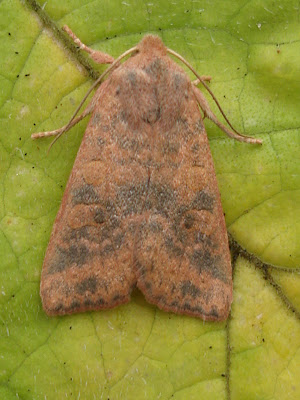
The first lot of brent geese newly arrived from Siberia, will have enjoyed the sunshine around the Colne estuary on Thursday 30th. Having had several days of showers recently, the clear sky and warmth in the sunshine was a welcome respite from the dull and damp weather.
Five brent geese seen flying past the Point on Tuesday were the first ones seen off East Mersea this autumn. According to reports from the Frinton stretch of the Essex coast, at least 2000 brent flew past there yesterday. Here in the Colne today 100 birds were present, in 3 or 4 groups feeding out on the mudflats. As usual one of the regular spots to see the geese was at the freshwater outflow along from Batemans Tower at Brightlingsea.
At the Point the stonechat was still present on bushes as was a wheatear on the beach, while Steve Entwistle saw a curlew sandpiper with 4 knot in the early evening. Two days earlier Andy Field had seen the stonechat with a whinchat, while the curlew sandpiper was with some dunlin near the Point. There was also a noisy flypast the Point from a sandwich tern too. Twenty five linnets and 3 reed buntings were also present on Tuesday.
On the park pond on Thursday the kingfisher put on a very lively show, splashing into the water several times, whistling at every opportunity and then flying short distances to perch on another willow branch. The sunshine showed up the bright colours of the birds, especially the bright blue flash along the back. Also near the pond 12 jays seemed a notable flock as they flew high along a hedgerow. Four blackcaps were seen in one bush soaking up the morning sunshine. Along the clifftop trees 3 goldcrests were heard calling in the afternoon.

The late September sunshine gave this adder by the dell, one last burst of sunshine before it heads underground for the winter. Elsewhere amongst the long grass 2 common lizards were basking and a wasp spider was also spotted on her web in the grass.
It was a good day for small copper butterflies with a possible site record count of 16 individuals seen at the park. They seemed to be in most corners of the park especially around patches of sheep's sorrel plants. Also seen were 2 red admirals, 2 small whites, comma and speckled wood.

The moth trap was left running on the dry night of Tuesday which lured in 110 moths of 17 species including this barred sallow moth pictured above with its autumnal tint markings.

Another autumnal moth is this handsome black rustic pictured above, which turns up at this time of year in small numbers.

This feathered ranunculus in the photo above, is the first one of the season. Like the black rustics, there are usually several recorded each autumn at the trap.
Other moths noted from Tuesday night included autumnal rustic, lunar underwing, mallow, riband wave, turnip, L-album wainscot, frosted orange, white-point, snout, square-spot rustic, brindled green and the brick.
 Masses of craneflies were swarming inside the moth trap by morning, attracted in during the night by the bright light. All over the park during the day there are thousands of craneflies, many following you inside your house too.
Masses of craneflies were swarming inside the moth trap by morning, attracted in during the night by the bright light. All over the park during the day there are thousands of craneflies, many following you inside your house too.Hugh Owen reported from the nearby Langenhoehall marshes to the north of Mersea, that on Tuesday afternoon he saw a common buzzard, ringtail hen harrier and also an osprey sitting on a dead tree that got briefly mobbed by a marsh harrier. It was a rich reward for the long hours he worked hard earlier in the day gardening!








































